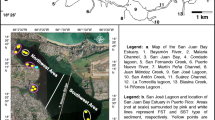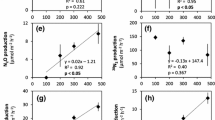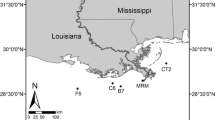Abstract
Intact sediment cores from rivers of the Bothnian Bay (Baltic Sea) were studied for denitrification based on benthic fluxes of molecular nitrogen (N2) and nitrous oxide (N2O) in a temperature controlled continuous water flow laboratory microcosm under 10, 30, 100, and 300 μM of 15N enriched nitrate (NO3 −, ~98 at. %). Effluxes of both N2 and N2O from sediment to the overlying water increased with increasing NO3 − load. Although the ratio of N2O to N2 increased with increasing NO3 − load, it remained below 0.04, N2 always being the main product. At the NO3 − concentrations most frequently found in the studied river water (10–100 μM), up to 8% of the NO3 − was removed in denitrification, whereas with the highest concentration (300 μM), the removal by denitrification was less than 2%. However, overall up to 42% of the NO3 − was removed by mechanisms other than denitrification. As the microbial activity was simultaneously enhanced by the NO3 − load, shown as increased oxygen consumption and dissolved inorganic carbom efflux, it is likely that a majority of the NO3 − was assimilated by microbes during their growth. The 15N content in ammonium (NH4 +) in the efflux was low, suggesting that reduction of NO3 − to NH4 + was not the reason for the NO3 − removal. This study provides the first published information on denitrification and N2O fluxes and their regulation by NO3 − load in eutrophic high latitude rivers.



Similar content being viewed by others
References
An S, Gardner WS (2002) Dissimilatory nitrate reduction to ammonium (DNRA) as a nitrogen link, versus denitrification as a sink in a shallow estuary (Laguna Madre/Baffin Bay, Texas). Mar Ecol Prog Ser 237:41–50. doi:10.3354/meps237041
Anderssen JM (1977) Rates of denitrification of undisturbed sediment from six lakes as a function of nitrate concentration, oxygen and temperature. Arch Hydrobiol 2:147–159
Bange HW, Rapsomanikis S, Andreae MO (1996) Nitrous oxide in coastal waters. Global Biogeochem Cycles 10:197–207. doi:10.1029/95GB03834
Blackmer AM, Bremner JM (1978) Inhibitory effect of nitrate on reduction of N2O to N2 by soil microorganisms. Soil Biol Biochem 10:187–191. doi:10.1016/0038-0717(78)90095-0
Bonin P (1996) Anaerobic nitrate reduction to ammonium in two strains isolated from coastal marine sediment: a dissimilatory pathway. FEMS Microbiol Ecol 19:27–38. doi:10.1111/j.1574-6941.1996.tb00195.x
Bonin P, Ornnes P, Chalamet A (1998) Simultaneous occurrence of denitrification and nitrate ammonification in sediments of the French Mediterranean coast. Hydrobiologia 389:169–182
Brunet RC, Garcia-Gil LJ (1996) Sulfide-induced dissimilatory nitrate reduction to ammonia in anaerobic freshwater sediments. FEMS Microbiol Ecol 21:131–138. doi:10.1111/j.1574-6941.1996.tb00340.x
Christensen PB, Sørensen J (1986) Temporal variation of denitrification activity in plant-covered, littoral sediment from lake Hampen, Denmark. Appl Environ Microbiol 51:1174–1179
de Bie MJM, Middelburg JJ, Starink M et al (2002) Factors controlling nitrous oxide at the microbial community and estuarine scale. Mar Ecol Prog Ser 240:1–9. doi:10.3354/meps240001
Elkins JW, Wofsy SC, McElroy MB et al (1978) Aquatic sources and sinks for nitrous oxide. Nature 275:602–606. doi:10.1038/275602a0
García-Ruiz R, Pattinson SN, Whitton BA (1998a) Denitrification in river sediments: relationship between process rate and properties of water and sediment. Freshw Biol 39:467–476. doi:10.1046/j.1365-2427.1998.00295.x
García-Ruiz R, Pattinson SN, Whitton BA (1998b) Kinetic parameters of denitrification in a river continuum. Appl Environ Microbiol 64:2533–2538
García-Ruiz R, Pattinson SN, Whitton BA (1999) Nitrous oxide production in the river Swale-Ouse, North-East England. Water Res 33:1231–1237. doi:10.1016/S0043-1354(98)00324-8
Goyens L, de Vries RIP, Bakker JF, Helder W (1987) An experiment on the relative importance of denitrification, nitrate reduction and ammonification in coastal marine sediment. Neth J Sea Res 21:171–175
Gran V, Pitkänen H (1999) Denitrification in estuarine sediments in the eastern Gulf of Finland, Baltic Sea. Hydrobiologia 393:107–115. doi:10.1023/A:1003530907516
Hauck RD, Melsted SW, Yanlwitch PE (1958) Use of N-isotope distribution in nitrogen gas in the study of denitrification. Soil Sci 86:287–291. doi:10.1097/00010694-195811000-00011
Hietanen S (2007) Anaerobic ammonium oxidation in sediments of the Gulf of Finland. Aquat Microb Ecol 48:197–205
Hulth S, Aller RC, Canfield DE et al (2005) Nitrogen removal in marine environments: recent findings and future research challenges. Mar Chem 94:125–145. doi:10.1016/j.marchem.2004.07.013
Jenkins MC, Kemp WM (1985) The coupling of nitrification and denitrification in two estuarine sediments. Limnol Oceanogr 29:609–619
Jørgensen KS (1989) Annual pattern of denitrification and nitrate ammonification in estuarine sediment. Appl Environ Microbiol 55:1841–1847
Jørgensen KS, Sørensen J (1988) Two annual maxima of nitrate reduction and denitrification in estuarine sediment (Norsminde Fjord, Denmark). Mar Ecol Prog Ser 48:147–154. doi:10.3354/meps048147
Kana TD, Sullivan MB, Cornwell JC et al (1998) Denitrification in estuarine sediments determined by membrane inlet mass spectrometry. Limnol Oceanogr 43:334–339
Kaspar HF (1983) Denitrification, nitrate reduction to ammonium, and inorganic nitrogen pools in intertidal sediments. Mar Biol 74:133–139
Kaspar HF, Asher RA, Boyer IC (1985) Microbial nitrogen transformations in sediments and inorganic nitrogen fluxes across the-sediment/water interface on the South Island West Coast, New Zealand. Estuar Coast Shelf Sci 21:245–255
Koch MS, Maltby E, Oliver GA et al (1992) Factors controlling denitrification rates of tidal mudflats and fringing salt marshes in South-West England. Estuar Coast Shelf Sci 34:471–485. doi:10.1016/S0272-7714(05)80118-0
Kroeze C, Seitzinger SP (1998) Nitrogen inputs to rivers, estuaries and continental shelves and related nitrous oxide emissions in 1990 and 2050: a global model. Nutr Cycl Agroecosyst 52:195–212. doi:10.1023/A:1009780608708
Kronholm M, Albertson J, Laine A (eds) (2005) Perämeri Life. Perämeren toimintasuunnitelma. Länstyrelsen i Norrbottens län, raportserie 1/2005
Kuypers MM, Sliekers AO, Lavik K et al (2003) Anaerobic ammonium oxidation by anammox bacteria in the Black Sea. Nature 442:608–611. doi:10.1038/nature01472
Laursen AE, Seitzinger SP (2004) Diurnal patterns of denitrification, oxygen consumption and nitrous oxide production in rivers measured at the whole-reach scale. Freshw Biol 49:1448–1458. doi:10.1111/j.1365-2427.2004.01280.x
Law CS, Owens NJP (1990) Denitrification and nitrous oxide in the North Sea. Neth J Sea Res 25:65–74. doi:10.1016/0077-7579(90)90009-6
Liikanen A, Flöjt L, Martikainen PJ (2002a) Gas dynamics in eutrophic lake sediments affected by oxygen, nitrate and sulphate. J Environ Qual 31:338–349
Liikanen A, Tanskanen H, Murtoniemi T et al (2002b) A laboratory microcosm for simultaneous gas and nutrient flux measurements in sediments. Boreal Environ Res 7:151–160
Matheson FE, Nguyen ML, Cooper AB et al (2002) Fate of 15 N- nitrate in unplanted, planted and harvested wetland soil microcosms. Ecol Eng 19:249–264. doi:10.1016/S0925-8574(02)00093-9
McAuliffe C (1971) GC determination of solutes by multiple phase equilibration. Chemtech 1:46–51
McClain ME, Boyer EW, Dent CL et al (2003) Biogeochemical hot spots and hot moments at the interface of terrestrial and aquatic ecosystems. Ecosystems (NY, print) 6:301–312. doi:10.1007/s10021-003-0161-9
Middelburg JJ, Soetaert K, Herman PMJ (1996) Evaluation of the nitrogen isotope pairing technique for measuring benthic denitrification: a simulation analysis. Limnol Oceanogr 41:1833–1839
Nielsen K, Nielsen LP, Rasmussen P (1995) Estuarine nitrogen retention independently estimated by the denitrification rate and mass-balance method: a study of Norsminde Fjord, Denmark. Mar Ecol Prog Ser 219:25–40. doi:10.3354/meps219025
Nykänen H, Alm J, Lång K et al (1995) Emissions of CH4, N2O and CO2 from a virgin fen and a fen drained for grassland in Finland. J Biogeogr 22:351–357. doi:10.2307/2845930
Ogilvie B, Nedwell DB, Harrison RM et al (1997) High nitrate, muddy estuaries as nitrogen sinks: the nitrogen budget of the River Colne estuary (United Kingdom). Mar Ecol Prog Ser 150:217–228. doi:10.3354/meps150217
Oremland RS, Umberger C, Culbertson CW et al (1984) Denitrification in San Francisco bay intertidal sediments. Appl Environ Microbiol 47:1106–1112
Oren A, Blackburn TH (1979) Estimation of sediment denitrification rates in situ nitrate concentrations. Appl Environ Microbiol 37:174–176
Pfenning KS, McMahon PB (1996) Effect of nitrate, organic carbon and temperature on potential denitrification rates in nitrate-rich riverbeds. J Hydrol 187:283–295
Piña-Ochoa E, Álvares-Cobelas M (2006) Denitrification in aquatic environments: a cross-system analysis. Biogeochemistry 81:111–130. doi:10.1007/s10533-006-9033-7
Pind A, Risgaard-Petersen N, Revsbech NP (1997) Denitrification and microphytobenthic NO3 − consumption in a Danish lowland stream: diurnal and seasonal variation. Aquat Microb Ecol 12:275–284. doi:10.3354/ame012275
Risgaard-Petersen N, Nielsen LP, Rysgaard S et al (2003) Application of the isotope pairing technique in sediments where anammox and denitrification co-exist. Limnol Oceanogr Methods 1:63–73
Royer TV, Tank JL, David MB (2004) Transport and fate of nitrate in headwater agricultural streams in Illinois. J Environ Qual 33:1296–1304
Russow R (1999) Determination of 15N in 15N-enriched nitrite and nitrate in aqueous samples by reaction continuous-flow quadrupole mass spectrometry. Rapid Commun Mass Spectrom 13:1334–1338. doi:10.1002/(SICI)1097-0231(19990715)13:13<1334::AID-RCM606>3.0.CO;2-C
Russow R, Förstel H (1993) Use of GC-QMS for stable isotope analysis of environmentally relevant main and trace gases in the air. Isot Environ Health Stud 29:327–334. doi:10.1080/00211919308046700
Rysgaard S, Risgaard-Petersen N, Nielsen LP et al (1993) Nitrification and denitrification in lake and estuarine sediments measured by the N-15 dilution technique and isotope pairing. Appl Environ Microbiol 59:2093–2098
Seitzinger SP (1988) Denitrification in freshwater and coastal marine ecosystems: ecological and geochemical significance. Limnol Oceanogr 33:702–724
Seitzinger SP, Kroeze C (1998) Global distribution of nitrous oxide production and N inputs in freshwater and coastal marine ecosystems. Global Biogeochem Cycles 12:93–113
SFS standardization (1976) SFS-3032. Determination of ammonium-nitrogen of water
Siegel RL, Hauck RD, Kurtz LT (1982) Determination of 30N2 and application to measurement of N2 evolution during denitrification. Soil Sci Soc 46:68–74
Spott O, Stange CF (2007) A new mathematical approach for calculating the contribution of anammox, denitrification, and atmosphere to an N2 mixture based on a 15N tracer technique. Rapid Commun Mass Spectr 21:2398–2406
Stange CF, Spott O, Apelt B et al (2007) Automated and rapid online determination of 15 N abundance and concentration of ammonium, nitrite or nitrate in aqueous samples by the SPINMAS technique. Isot Environ Health Stud 43:227–236
Stockenberg A, Johnstone RW (1997) Benthic denitrification in the Gulf of Bothnia. Estuar Coast Shelf Sci 45:835–843
Thamdrup B, Dalsgaard T (2002) Production of N2 through anaerobic ammonium oxidation coupled to nitrate reduction in marine sediments. Appl Environ Microb 68:1312–1318
Trimmer M, Nedwell DB, Sivyer DB et al (1998) Nitrogen fluxes through the lower estuary of the river Great Ouse, England: the role of the bottom sediments. Mar Ecol–Prog Ser 163:109–124
Trimmer M, Risgaard-Petersen N, Nicholls JC et al (2006) Direct measurement of anaerobic ammonium oxidation (anammox) and denitrification in intact sediment cores. Mar Ecol–Prog Ser 326:37–47
Tuominen L, Heinänen A, Kuparinen J et al (1998) Spatial and temporal variability of denitrification in the sediments of the northern Baltic proper. Mar Ecol–Prog Ser 172:13–24
Weier KL, Doran JW, Power JF et al (1993) Denitrification and the Dinitrogen/Nitrous Oxide ratio as affected by soil water, available carbon, and nitrate. Soil Sci Soc Am J 57:66–72
Acknowledgments
We thank Jaana Rintala (North Ostrobothnia Regional Environmental Centre) for providing maps. Bernd Apelt is acknowledged for his assistance with the laboratory work and Antti Ollila for providing equipment for the sediment sampling. We are grateful to the anonymous referees for their valuable comments. This study was funded by the Academy of Finland (decision number 202429) and H. S. got funding from the Graduate School of Environmental Science and Technology (EnSTe) and the Ella and Georg Ehrnrooth Foundation.
Author information
Authors and Affiliations
Corresponding author
Rights and permissions
About this article
Cite this article
Silvennoinen, H., Liikanen, A., Torssonen, J. et al. Denitrification and nitrous oxide effluxes in boreal, eutrophic river sediments under increasing nitrate load: a laboratory microcosm study. Biogeochemistry 91, 105–116 (2008). https://doi.org/10.1007/s10533-008-9262-z
Received:
Accepted:
Published:
Issue Date:
DOI: https://doi.org/10.1007/s10533-008-9262-z




